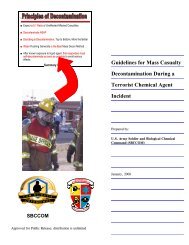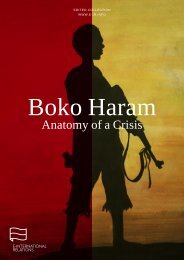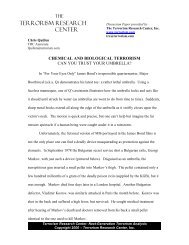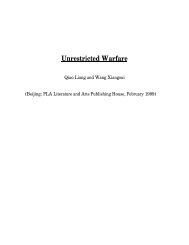Combating Proliferation of Weapons of Mass Destruction
Combating Proliferation of Weapons of Mass Destruction
Combating Proliferation of Weapons of Mass Destruction
Create successful ePaper yourself
Turn your PDF publications into a flip-book with our unique Google optimized e-Paper software.
ole as a supplier <strong>of</strong> ballistic missiles to aquire WMD materials and components, especiallyfor nuclear weapons. Iran has manufactured and stockpiled chemical weapons, includingblister, blood, and choking agents, as well as the bombs and artillery shells with which todeliver them. In fact, most <strong>of</strong> the seven state sponsors <strong>of</strong> terrorism (Cuba, Iran, Iraq,Libya, North Korea, Sudan, and Syria) either have or are seeking weapons <strong>of</strong> massdestruction. More than a dozen states have <strong>of</strong>fensive chemical and/or biologicalweapons programs. And despite seven years <strong>of</strong> intrusive on-site inspections, the UnitedNations Special Commission (UNSCOM) and the International Atomic Energy Agency (IAEA)have not been able to certify that Iraq’s WMD programs have been eliminated.Nuclear weapons can be delivered in the back <strong>of</strong> a truck or covertly launched from a merchantship, chemical weapons dispersed from a paper bag, and biological weapons spread by acrop duster. These “low-tech” delivery methods are likely to be favored by terrorists. Statethreats, however, include the use <strong>of</strong> WMD loaded on cruise or ballistic missiles. Here, too, therisk is growing. In August 1998, North Korea unexpectedly launched a three-stage TaepoDong-1 ballistic missile over Japanese territory. This followed a previously successsful testflight <strong>of</strong> North Korea’s No Dong ballistic missile over Japanese territory in May 1993. NorthKorea’s missile-related exports to Iran helped Tehran “save years” in the development <strong>of</strong> theShahab-3 missile, tested in 1998. 4Diversion <strong>of</strong> nuclear, chemical, or biological weapons, technology, materials,or expertise from Russia:We know <strong>of</strong> seven instances since 1992 in which weapons-usable fissile materials werestolen from Russian facilities. The continuing economic meltdown in Russia hasheightened the risk <strong>of</strong> both further material leakage and the “brain drain” <strong>of</strong> technicalexpertise. Russia has no reliable inventory <strong>of</strong> its fissile material, and Russian vulnerabilityto an “insider” threat is increased by power outages at Russian nuclear installations, by theneed for unpaid guards and technicians to forage for food, and by sporadic violence bothby and against personnel from the Ministries <strong>of</strong> Defense and Atomic Energy. Manydangerous state and sub-national actors would like to exploit Russia’s troubles in order toacquire nuclear weapons or small quantities <strong>of</strong> weapons-usable materials.China’s role as a significant proliferator <strong>of</strong> ballistic missiles, weapons <strong>of</strong>mass destruction, and enabling technologies:China has carried out extensive transfers to Iran’s solid-fuel ballistic and cruise missileprograms. It has supplied Pakistan with a design for a nuclear weapon and additional nuclearweapons ballistic missile assistance. It has transferred complete ballistic missile systems toSaudi Arabia (the 3,100-kilometer range CSS-2) and Pakistan (the 350-kilometer range4Id. at 4.2







